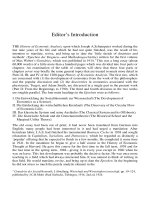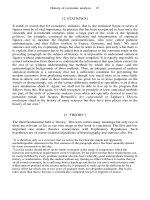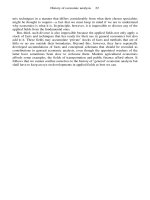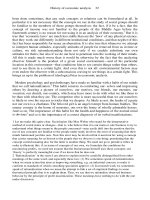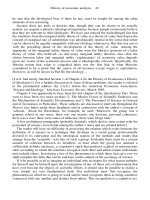History of Economic Analysis part 4 ppsx
Bạn đang xem bản rút gọn của tài liệu. Xem và tải ngay bản đầy đủ của tài liệu tại đây (55.28 KB, 10 trang )
Editor’s Introduction
THE History of Economic Analysis, upon which Joseph A.Schumpeter worked during the
last nine years of his life and which he had not quite finished, was the result of his
intention to translate, revise, and bring up to date the ‘little sketch of doctrines and
methods’ (Epochen der Dogmen—und Methodengeschichte) written for the first volume
of Max Weber’s Grundriss, which was published in 1914.
1
This was a long essay (about
60,000 words) of a little more than a hundred pages which was divided into four parts or
chapters. An examination of the table of contents will show that these four parts or
chapters cover very briefly the same general topics that are treated in much more detail in
Parts II, III, and IV of the 1200-page History of Economic Analysis. The first two, which
are concerned with (1) the development of economics from the work of the philosophers
and the popular discussion and (2) the discoveries in economics associated with the
physiocrats, Turgot, and Adam Smith, are discussed in a single part in the present work
(Part II: From the Beginnings to 1790). The third and fourth divisions in the two works
are roughly parallel. The four main headings in the Epochen were as follows:
I. Die Entwicklung der Sozialökonomik zur Wissenschaft (The Development of
Economics as a Science).
II. Die Entdeckung des wirtschaftlichen Kreislaufs (The Discovery of the Circular Flow
of Economic Life).
III. Das klassische System und seine Ausläufer (The Classical System and its Offshoots).
IV. Die historische Schule und die Grenznutzentheorie (The Historical School and the
Marginal Utility Theory).
The old essay had been out of print; it had never been translated from German into
English; many people had been interested in it and had urged a translation. After
herculean labor, J.A.S. had finished his monumental Business Cycles in 1938 and sought
relaxation in Capitalism, Socialism, and Democracy, which he regarded as distinctly a
‘popular’ offering that he expected to finish in a few months. He completed it some time
in 1941. In the meantime he began to give a half course in the History of Economic
Thought at Harvard. He gave this course for the first time in the fall term, 1939 and for
the last time in the spring term, 1948—giving it in every year except in 1940 when he
was on leave. This last development was probably the decisive factor. He was once more
teaching in a field which had always interested him. It was natural to think of writing in
that field. He would translate, revise, and bring up to date the Epochen. In the beginning
he did not stress so much the purely analytic element in the
1
Grundriss der Sozialökonomik, I.Abteilung, Wirtschaft und Wirtschaftswissenschaft, pp. 19–124,
published by J.C.B.Mohr (Paul Siebeck), Tübingen, 1914; 2nd ed. 1924.
writings of the economists discussed in his course and about whom he wrote. In fact, for
a long time I had the impression that he was writing a history of economic thought.
His original plan was not a very ambitious one. He certainly had no intention of
spending nine or ten years on a history of economic analysis. At first he probably thought
of giving his spare time for a few months or a year to a little book of three or four
hundred pages. Later he thought of one large volume of six or seven hundred pages. His
main interest was his work on theory and he planned to write his major contribution in
this field. He worked constantly at his mathematics because he believed it to be an
indispensable tool of modern theory. He envisaged a theory which might some day
synthesize dynamic economics in the same way that the Walrasian system summed up
static economics. Eventually he modified this program to the extent that he would first
write a little Introduction to Theory which would be for this kind of theory what the
General Theory of Employment, Interest, and Money was for Keynesian theory. He read
the current theoretical literature (largely in periodicals), worked at his mathematics, and
assembled voluminous notes. The results of this work are reflected in some of the later
parts of the History, especially in those parts which sum up modern developments.
It is hard to say just why his work on the History constantly became more and more
elaborate and took up more and more of his time. It was partly because his interests were
constantly broadening, and he found it increasingly difficult to treat very briefly
something which was to him a fascinating development. (For example, the scholastics
and the philosophers of natural law became an absorbing interest in the early forties.)
Here also he could weave together the threads of all his interests—philosophy, sociology,
history, theory, and such applied fields in economics as money, cycles, public finance,
socialism. I believe also that the war had something to do with it. I remember his telling
one or two friends that he found work on the History a rather soothing occupation for
wartime. It removed him temporarily from a grim reality which grieved him beyond
measure because he was convinced it would destroy the civilization he loved.
As always he wrote out everything in his own hand and kept everything that he wrote.
It is possible to see, therefore, how the early treatments became more and more elaborate.
He probably began writing the History in 1941. During the years 1942 and 1943 he seems
to have had typed a good many chapters and sections, most of which were subsequently
revised. The only substantial parts of the History written in the early years which were
not later rewritten are the chapter The ‘Mercantilist’ Literature, which was typed in June
1943, the chapter on Sozialpolitik and the Historical Method, part of which was typed in
January 1943 and the rest in December 1943, and the section on Senior’s Four Postulates
at the beginning of Chapter 6 of Part III (General Economics: Pure Theory). These, too,
would probably have been revised or rewritten had J.A.S. lived to complete the History.
Occasionally a few pages of an earlier version were incorporated in later versions. This
process is described in some detail in the Appendix.
As time went on, he began to emphasize that this was a history of economic analysis
and not a history of economic thought. He makes this clear in a brief description which
he wrote early in 1949 for his English publishers, Allen & Unwin, in which he stated:
This book will describe the development and the fortunes of scientific
analysis in the field of economics, from Graeco-Roman times to the
present, in the appropriate setting of social and political history and with
some attention to the developments in other social sciences and also in
philosophy. The ideas on economic policy that float in the public mind or
may be attributed to legislators and administrators, whether or not
embodied in elaborate systems, such as liberalism or solidarism and the
like, which are commonly referred to as economic thought, come in only
as part of that setting. The subject of the book is the history of the efforts
to describe and explain economic facts and to provide the tools for doing
so.
Since the very possibility of treating the history of economics like the
history of any other science is controversial, Part I of the book is devoted
entirely to the methodological questions that this approach raises and
especially to the question how far the distinction between scientific
economic analysis and economic thought is valid in spite of the
interaction between the two. Part II then tells the story of the growth of
historical, statistical, and theoretical knowledge of economic phenomena
from its beginnings in ancient Greece to the emergence of economics as a
recognized special field and to the consequent appearance in the second
half of the eighteenth century of systematic treatises, of which A.Smith’s
Wealth of Nations proved to be the most successful one.
Part III covers the period between 1776 [later changed to 1790] and
1870, and Part IV the period between 1870 and 1914. Part V is to help the
reader to relate the present state of economics to the work of the past.
Throughout, an effort has been made to make the most important contour
lines stand out without sacrificing correctness to simplicity of exposition.
I stated at the beginning that J.A.S. had been working on his History of Economic
Analysis during the last nine years of his life. In a larger sense, he had been working on it
all his life. Probably all of his writing and all of his teaching contributed to the final
result. The lecture which he gave on leaving Czernowitz in 1911, for example, was
entitled ‘Vergangenheit und Zukunft der Sozialwissenschaften.’
2
This was a brief outline
of what first became the Epochen and finally the History of Economic Analysis. His
Presidential Address before the American Economic Association in December 1948—
‘Science and Ideology’—was concerned with some of these problems of methodology
which he takes up in Part I of the History. The course which he gave at Harvard on the
History of Economic Thought covered essentially the period between A.Smith and
A.Marshall, with special emphasis on the Ricardian system of economic theory. In the
course on Advanced Economic Theory
3
he discussed many of the problems which are
written about in Part IV, Chapter 7 (Equilibrium Analysis) and in Part V. He also taught
at Harvard a course on Socialism and sometimes a course on Business Cycles and the
course on Money. At the University of Bonn, J.A.S. held the Chair of Public Finance, but
2 ‘The Past and Future of the Social Sciences.’ A revised and enlarged version was published by
Duncker & Humblot (1915) in the Schriften des Sozialwissenschaftlichen Akademischen Vereins
in Czernowitz.
3 At the beginning of the reading list for this course (Economics 203a) in the fall term of 1948–9
occurs the following brief description:
also conducted a seminar which was concerned largely with theory, including the theory
of money, and with epistemology. While at Yale for a year, he taught the course in
International Trade. Not only his courses, but also his many articles on almost every
aspect of economics, his numerous book reviews, his biographical essays, his books—all
were part of the preparation for writing the History of Economic Analysis. Even his
reading for pleasure and recreation—he loved to read biographies, preferably those in
many volumes—contributed to that fascinating knowledge of men, events, and
backgrounds which is apparent throughout the History and which will liven for some
readers sober discussions on fine points of economic analysis.
No part of the manuscript was in final form but some parts were more nearly complete
than others. The three main Parts (II, III, and IV) were practically finished, with the
exceptions noted in the Appendix; the introductory Part I and the concluding Part V were
being written at the very end. The last thing written, at the close of 1949, was apparently
the chapter on Keynes and Modern Macroeconomics at the end of Part V. This was left
behind to be typed when he went to Taconic for Christmas and to New York for the
meetings of the American Economic Association. On his return from the meetings, he
started to write up his address, ‘The March into Socialism,’ and also to read the typescript
of Part III of the History. He left several pages of notes for revisions in the first three or
four chapters in this part on ‘classical’ economics. His death on January 8, 1950, made it
impossible for him ever to carry out these revisions.
The entire History was first written in longhand. Some portions, such as the early
chapter on Money (Part II, ch. 6) and much of the material on the
The primary object of this course is to train the students in the art of
conceptualizing the salient features of the economic process. But
discussion of individual problems will give the opportunity of rehearsing
critically large parts of traditional theory, old and new. The program for
this term includes, first, a preliminary survey of certain fundamental
notions, especially determinateness and stability; second, the general
dynamics of economic aggregates; third, the general theory of the
behavior of households and firms. Though some knowledge of the
calculus and of differential equations is desirable, purely mathematical
aspects will not be stressed.
Walrasian system of equilibrium (Part IV, ch. 7, sec. 7), existed only in longhand and had
never been typed. In a few cases there were even several alternative versions in longhand.
Other portions had been typed but not read by the author after typing. Still others had
been read in typescript and corrected in pencil with notes and questions for subsequent
revision. There were occasional references to be filled in, and J.A.S. told me that the
references needed to be checked. I was to have helped at this task. The interested
professional reader will find more detailed information on these points in editorial notes
throughout the work and in the Editor’s Appendix.
J.A.S. had no regular secretarial assistance during most of the period when he worked
on this book, but he did have people who knew his handwriting and who typed for him.
Occasionally he sent off a large batch of completed manuscripts to be typed. He wrote
most of his letters in his own hand. This, of course, added immensely to the burden of his
work and meant that his material was never filed as an efficient secretary might have
filed it. He did not acquire a part-time secretary until the summer of 1948, when he was
president of the American Economic Association and simultaneously carrying on all his
other work. Even then he was reluctant to take the time to instruct her properly because
the days and weeks were never long enough to do all the things he planned to do—his
teaching, his consultations, his reading, his writing, his correspondence.
I conceived my editorial task to be the simple one of presenting as complete and
accurate a version of what J.A.S. actually wrote as possible but not to attempt to complete
what he had not written. No outline of the whole work existed, and I had read none of it
before his death because J.A.S. wished me to begin with the introduction, upon which he
was working, and to read the whole work in its proper order. The material was found in
many places—some of it in file boxes, some of it piled on shelves—in the Cambridge
study on Acacia Street, in the Taconic study, and a little of it in his office at Littauer
Center. It took me two or three months to discover that the History was nearly completed,
and sections or subsections kept turning up for some time. The initial fitting together of
the pieces was made difficult by the fact that the manuscript pages were often not
numbered at all, and that the typescript was not numbered consecutively from the
beginning but only in small batches as typed. J.A.S. used only the first typescript for the
publisher. He never bothered with a carbon copy for himself. Fortunately the various
people who typed the manuscript kept a carbon copy, and these carbon copies were
stacked in a room on the third floor of the Acacia Street house. Some of these—those
done in 1943 and 1944 especially—were dated. I kept looking until I found manuscript
and a first typescript to match the carbons. In a number of cases, the carbons represented
early treatments subsequently discarded or partially incorporated in later versions. As I
read the whole work over and over again I found that, though no outline or table of
contents had been written out, such an outline existed within the text. There was a minor
complication due to the fact that the number of chapters originally planned was reduced
from eight to seven in the case of Part II and from ten to eight in the case of Part IV. In
the end, however, I had almost no difficulty in determining where each section or
subsection belonged or in deciding which was the latest of two or more versions. These
problems are discussed in the Appendix.
The task was immensely complicated by the length of the book. Even though I am an
economist with some editorial experience, it was not easy to put together so long a work
dealing with so many economists, writing in so many languages over so long a period. In
general, the procedure was as follows: the sections still in manuscript were typed; then
various assistants read the manuscript to me from beginning to end while I corrected the
typescript; references were completed and checked; titles and subtitles were supplied
where necessary; after the Oxford University Press edited the typescript, I went through it
once more to pass on the changes made, to supply cross references to other parts of the
work, to check against a card catalogue of authors; finally various assistants read the
author’s copy to me from beginning to end while I corrected the galley proofs. During
each successive reading of the History, more and more minor inaccuracies and
uncertainties were cleared up. Doubtless this process could have gone on indefinitely, but
considerations of time imposed a reasonable stopping place. It seems appropriate at this
point to acknowledge gratefully a gift from David Rockefeller and a grant from the
Rockefeller Foundation which made possible much of the secretarial and editorial
assistance outlined above.
One difficulty should perhaps be touched upon here. It applies especially to the
unfinished portions of the History. J.A.S. often started and abandoned many treatments of
the same subject. He kept all these trial efforts and his original notes together with the
finished bits of manuscript so that it was not always easy to know what was a more or
less final version. Sometimes the date of a reference or the incorporation of a page or two
of an earlier version was a clue. Another difficulty is that his plans or his notes for
revision were often in a mixture of English, German, and shorthand. Four pages of such
notes are reproduced in the Appendix (the plan and the final page for the money chapter
in Part II and two outlines for Part V). I made no effort to interpret or carry into effect
either such shorthand revisions or brief suggestions as to revisions. I merely incorporated
the straightforward corrections on the first typescript. The original manuscript, the
alternative versions, the notes, and the first typescript with corrections and suggested
revisions in the hand of J.A.S. will all be deposited in the Houghton Library at Harvard
University, where they may be consulted by the interested scholar.
Material has been added by the editor only for clarity or consistency, and such
additions are enclosed in square brackets. This applies especially to titles and subtitles,
editorial notes in the text, and editorial footnotes. In the beginning, J.A.S. merely
numbered his sections. As time went on, he added titles for both sections and subsections.
Occasionally he left a blank where he had not made a final decision. The titles supplied
by the editor were based on the text and are all enclosed in square brackets. There are
both author’s comments and editor’s notes in square brackets, but it is almost always
possible to distinguish between them. The author’s comments are usually in the midst of
quotations, whereas the editor’s material occurs as complete sentences at the end of
notes, as complete footnotes, or as a complete paragraph in the text printed in the
footnote type. Where there is danger of confusion, the initials ‘J.A.S.’ or the abbreviation
‘Ed.’ are used.
There are some repetitions, of which J.A.S. was well aware, and some omissions of
material promised ‘above’ or ‘below.’ For the most part, I did not attempt to eliminate
repetitions except such as were very close together and obvious. When the same article
was quoted several times in different connections or the same idea expressed several
times in different parts of the text, I did not feel competent to remove some references
and leave others, although the author himself would have done so. I have attempted to
call attention in footnotes to the more important omissions, which were the consequence
of some parts of the work being not quite complete. At the suggestion of Richard
M.Goodwin, I also called attention in footnotes to some of the other writings of the
author which had a bearing on problems under discussion, since J.A.S. hardly ever
referred to his own work either in his teaching or in his writing. Other people could
doubtless have done this better but no one else had the time to go through this long work
again and again.
Occasionally it was impossible to read a word or a word was omitted or a sentence
was incomplete. I dealt with such problems to the best of my ability. The vocabulary used
was extensive and many an unusual English word had to be tracked down in the great
Oxford Dictionary. Many of the foreign titles quoted were not to be found in any of the
Harvard Libraries, nor were they listed by the Library of Congress. By using various
foreign book lists and with the help of scholars in this country and in Europe, I was able
eventually to verify almost all the authors and titles.
For the most part, J.A.S. was specific about the editions used where this was
important, but occasionally there was a little difficulty in this connection, because the
author had worked in so many places over such a long period that inevitably he had used
different editions and printings of the works quoted. He undoubtedly used European
university libraries and his own extensive library for his notes and writings before he
came to Harvard in 1932. At that time his library was packed up and stored in Jülich near
Bonn. It was not brought to the United States before the war because at first he did not
have room for it and later there were various ‘practical difficulties’ (perhaps more
imaginary than real). Then came the war. Eventually it was destroyed in the bombing of
Jülich by the American Air Force. Only about a hundred books (mostly English
biographies) were salvaged from the rubble. After 1932, J.A.S. used working books
acquired in this country and my library of economics books in Taconic. He spent much
time during the war working quietly in the Kress Library of Business and Economics at
the Harvard School of Business Administration. (He also read extensively in the
professional periodical literature, and he read the current books and reprints in many
languages which scholars everywhere sent him.) This may help to explain why both
earlier and later editions of the same work are listed in the History and why I found page
references to two different English translations of Volume I of Das Kapital and to both
English and American editions of Cairnes (Some Leading Principles) and Keynes (Tract
on Monetary Reform). The original work on Turgot’s Réflexions was obviously done
before the publication of the Schelle edition.
There is no attempt to present a bibliography with this History of Economic Analysis.
In a sense the whole history may be regarded as a bibliography. I do, however, present a
list of books frequently quoted where the edition used is important and where this is not
specifically mentioned on each occasion. J.A.S. used the fourth edition of Marshall’s
Principles (1898) because both he and I owned this edition. (He had many qualms about
this and wondered if he shouldn’t shift to a later edition.) This list of books (with the
edition or printing used) is to be found at the end of the work, following directly after the
Appendix.
The reader may be puzzled by the significance of the indented material which occurs
in the first 566 pages of this work. It must be admitted at once that this is an error, the
consequence of a misunderstanding between the printer and publisher on the one hand
and the editor on the other. All the indented material should have been set in footnote
type (not indented) as being supposedly of lesser interest to the average reader. It will be
recalled that J.A.S. was attempting to write a history which could be published in one
volume of possibly six or seven hundred pages. As time went on, however, his treatment
became more and more elaborate, and he was aware of the fact that the book was getting
too long—also that he was treating subjects which might not interest the average reader.
He therefore decided to write the book on two levels, with the more or less technical
material, the epistemological and philosophical discussions, and the biographical
sketches set in small type so that they would take up less space and so that they could be
easily skipped. He indicated this by having them typed in single space like the footnotes.
The printer, having chosen an appropriate type for the book, decided that there would be
too much of the small or footnote type and evolved the plan of putting this ‘secondary’
material in the text type but indented, thus reversing what the author had intended to be
the relative importance of this material. Unfortunately this plan was not made clear to me
and nearly half the History was in galleys before I saw any proof. Resetting all this would
have involved both considerable expense and considerable delay. I therefore let it stand
for the most part and had only small sections of incomplete or very technical discussion
reset in small type. A glance at pages 414–18, 449–52, and 464–9, where Comte, Mill’s
Logic, and Longfield, Thünen, and John Rae are discussed, will illustrate the kind of
material which the author intended to have subordinated. I am not sure that he was
always right in his emphasis, especially with reference to the biographical sketches,
which appeal to most people who have read them.
In the rest of the History (the last two chapters of Part III and Parts IV and V), I
divided the ‘secondary’ material between the text type and the footnote type, with only
two or three ‘philosophical’ discussions indented as had been done earlier. The
biographical sketches, some of which were rather long, were almost all printed in the
larger rather than in the smaller type, as originally intended. I did this because I was
persuaded that it would be difficult to read so much material in the very small footnote
type already chosen, although this change was, of course, contrary to my policy of
publishing the History as nearly as possible as J.A.S. had written it. The manuscript and
first typescript deposited in the Houghton Library will show what the author planned in
this respect.
It is possible for me to mention here only a very small number of the people without
whose advice or assistance I could not have prepared the work for publication. Arthur
W.Marget was the first person to read the entire History in typescript, to advise me about
the unfinished sections, and to discuss general editorial policy with me. He also put
together and edited the chapter on Value and Money in Part II. This chapter had never
been typed, the manuscript pages had not been numbered, and there was some
uncertainty about the order of the pages in a few cases. Gottfried von Haberler also read
most of the typescript and helped me check obscure references and any theoretical points
which troubled me. Paul M.Sweezy read all of the proof, made many valuable
suggestions, and caught several errors which had escaped me. Richard M.Goodwin first
put together for me the material in Part IV, Chapter 7, and Part V, which were unfinished
and upon which J.A.S. was working at the time of his death. This was the important
material upon equilibrium analysis and upon modern developments. Alfred H.Conrad
read some of the typescript and much of the proof and checked mathematical
formulations. William J.Fellner read some of the typescript, and Alexander Gerschenkron
read some of the proof. Frieda S.Ullian was both resourceful and indefatigable in tracking
down obscure authors. Anna Thorpe has helped at every stage of this book from typing
some of the early manuscript many years ago to helping me read proof and prepare an
index. Her familiarity with J.A.S.’s somewhat difficult handwriting and his methods of
work helped solve many a problem. My gratitude goes out to these people and to all the
others who helped me in one way or another to edit this History of Economic Analysis.
ELIZABETH BOODY SCHUMPETER
Taconic, Connecticut
July 1952
NOTE: After Professor Schumpeter’s death and up to the last weeks of her prolonged
illness, Mrs. Schumpeter devoted most of her time to preparing this book for publication.
At her death the author index was nearly finished, but the work on the subject index had
been barely started. Dr. Robert Kuenne undertook the difficult and extensive task of
preparing the subject index; he also completed the author index and co-ordinated the two.
The publishers are deeply grateful to Professor Wassily Leontief for his help in
making publication possible.
PART I
INTRODUCTION
SCOPE AND METHOD



